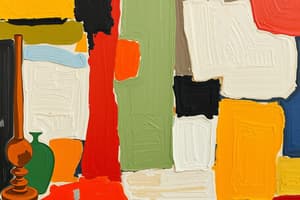Podcast
Questions and Answers
What did Symbolist artists aim to evoke in their artwork?
What did Symbolist artists aim to evoke in their artwork?
Emotions and refined sensibilities
What was the main focus of Expressionist artists in their art?
What was the main focus of Expressionist artists in their art?
Express emotion and inner feelings
Which famous painting by Edvard Munch exemplifies the psychological intensity of Expressionism?
Which famous painting by Edvard Munch exemplifies the psychological intensity of Expressionism?
The Scream
What did the painting "The Scream" effectively convey despite disregarding physical accuracy?
What did the painting "The Scream" effectively convey despite disregarding physical accuracy?
What marked a critical turning point in the evolution of art, leading to the emergence of more abstract forms?
What marked a critical turning point in the evolution of art, leading to the emergence of more abstract forms?
Which two art movements were influenced by the transition from Symbolism to Expressionism?
Which two art movements were influenced by the transition from Symbolism to Expressionism?
Who were some notable artists of the Renaissance period?
Who were some notable artists of the Renaissance period?
What are the characteristics that define Renaissance art?
What are the characteristics that define Renaissance art?
Where did the Renaissance period originate?
Where did the Renaissance period originate?
Which painting by Leonardo da Vinci exemplifies the subtlety and mystery of Renaissance art?
Which painting by Leonardo da Vinci exemplifies the subtlety and mystery of Renaissance art?
Which sculpture by Michelangelo showcases his ability to represent the human form with detail and realism?
Which sculpture by Michelangelo showcases his ability to represent the human form with detail and realism?
What was Symbolism a reaction against, and during which century did it emerge?
What was Symbolism a reaction against, and during which century did it emerge?
Study Notes
Art History is a vast field encompassing various periods, styles, and movements. Two significant subtopics within this discipline are Renaissance Art and the evolution from Symbolism to Expressionism.
Renaissance Art
The Renaissance was a period of tremendous artistic growth spanning approximately 14th to 17th centuries. It originated in Florence, Italy, where it emerged around 1400. Characterized by realism, humanism, and individuality, Renaissance artists aimed to capture the true essence of their subjects and convey a sense of depth and perspective through spatial representation. Some notable figures of this era include Leonardo da Vinci, Michelangelo, Raphael, and Titian. Their masterpieces continue to inspire and captivate audiences globally.
Leonardo da Vinci's Italian painting "Mona Lisa," which resides at the Louvre Museum in Paris, France, exemplifies the subtlety and mystery inherent in Renaissance art. On the other hand, Michelangelo's sculpture, "David," showcases the artist's ability to represent the human form with unparalleled detail and realism. These works were instrumental in shaping the course of Western art and remain some of its most iconic pieces.
Evolution from Symbolism to Expressionism
Symbolism was a movement in literature, visual arts, music, and philosophy, born primarily in Europe as a reaction against the rationalization of nature and society during the Age of Enlightenment in the late 19th century. Symbolist artists sought to evoke emotions and refined sensibilities rather than simply depict reality. In contrast, Expressionist artists wanted to express emotion and inner feelings rather than accurately portray external reality.
Edvard Munch's "Scream," painted in 1893, highlights the psychological intensity characteristic of Expressionism. As one of the most popular images in modern art, it effectively conveys an intense emotional response while disregarding physical accuracy. This shift from precise representation to emotional projection marked a critical turning point in the evolution of art, leading to the emergence of more abstract forms such as Cubism and Surrealism.
In conclusion, Art History offers a fascinating insight into the development of creative expression across time. Exploring periods like the Renaissance with its emphasis on realism and individuality, and witnessing the transition from Symbolism to Expressionism, which revolutionized how emotions were portrayed, serves to underscore the dynamic nature of artistic evolution.
Studying That Suits You
Use AI to generate personalized quizzes and flashcards to suit your learning preferences.
Description
Explore the Renaissance period known for realism and humanism, featuring iconic artists like Leonardo da Vinci and Michelangelo. Delve into the evolution from Symbolism to Expressionism, focusing on emotional projection over precise representation. Discover the dynamic evolution of artistic expression through key movements and figures in art history.




